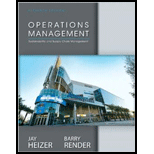
Concept explainers
Inventory Control at Wheeled Coach Video Case
Controlling inventory is one of Wheeled Coach’s toughest problems. Operating according to a strategy of mass customization and responsiveness, management knows that success is dependent on tight inventory control. Anything else results in an inability to deliver promptly, chaos on the assembly line, and a huge inventory investment. Wheeled Coach finds that almost 50% of the cost of every ambulance it manufactures is purchased materials. A large proportion of that 50% is in chassis (purchased from Ford), aluminum (from Reynolds Metal), and plywood used for flooring and cabinetry construction (from local suppliers). Wheeled Coach tracks these A inventory items quite carefully, maintaining tight security/control and ordering carefully so as to maximize quantity discounts while minimizing on-hand stock. Because of long lead times and
In a crowded ambulance industry in which it is the only giant, its 45 competitors don’t have the
Accurate bills of material (BOM) are a requirement if products are going to be built on time. Additionally, because of the custom nature of each vehicle, most orders are won only after a bidding process. Accurate BOMs are critical to cost estimation and the resulting bid. For these reasons, Collins was emphatic that Wheeled Coach maintain outstanding inventory control. The Global Company Profile featuring Wheeled Coach (which opens Chapter 14) provides further details about the ambulance inventory control and production process.
Discussion Questions *
* You may wish to view the video that accompanies this case before answering these questions.
- 1. Explain how Wheeled Coach implements ABC analysis.
- 2. If you were to take over as inventory control manager at Wheeled Coach, what additional policies and techniques would you initiate to ensure accurate inventory records?
- 3. How would you go about implementing these suggestions?
Want to see the full answer?
Check out a sample textbook solution
Chapter 12 Solutions
Operations Management
- The deaths are included in the discharges; this includes deaths occurring in less than 48 hours and postoperative deaths. Rehabilitation had 362 discharges, 22 deaths, 1<48 hours, 0 Postoperative. what is the gross death rate for the rehabilitation service?arrow_forwardA copy machine is available 24 hours a day. On a typical day, the machine produces 100 jobs. Each job takes about 3 minutes on the machine, 2 minutes of which is processing time and 1 minute is setup time (logging in, defining the job). About 20 percent of the jobs need to be reworked, in which case the setup time and the processing time have to be repeated. The remainder of the time, the equipment is idle. What is the OEE of the equipment?arrow_forwardHow do you think we can keep updating Toyota's ideas as new technologies come out and what customers want keeps changing?arrow_forward
- Given how TPS has helped change things in so many fields, do you think there are parts of it that might be hard to use in areas that aren’t about making things, like in healthcare or services? If so, why do you think that might be?arrow_forwardDo you feel there is anything positive about rework?arrow_forwardDo you think technology can achieve faster setup times? How would it be implemented in the hospital workforce?arrow_forward
- In your experience or opinion, do you think process changes like organizing workspaces make a bigger difference, or is investing in technology usually the better solution for faster setups?arrow_forwardHave you seen rework done in your business, and what was done to prevent that from occurring again?arrow_forwardResearch a company different than case studies examined and search the internet and find an example of a business that had to rework a process. How was the organization affected to rework a process in order to restore a good flow unit? Did rework hurt a process or improve the organization's operational efficiency? • Note: Include a reference with supportive citations in the discussion reply in your post.arrow_forward
- Setup time is very important in affecting a process and the capacity of a process. How do you reduce setup time? Give examples of reducing setup time. Please Provide a referenecearrow_forwardDo you think TPS was successful? If so, how? Are there other companies that have used TPS? If so, give examples. Please provide a referencearrow_forwardGiven the significant impact on finances, production timelines, and even equipment functionality, as you pointed out, what do you believe is the most effective single strategy a company can implement to significantly reduce the occurrence of rework within their operations?arrow_forward
 Purchasing and Supply Chain ManagementOperations ManagementISBN:9781285869681Author:Robert M. Monczka, Robert B. Handfield, Larry C. Giunipero, James L. PattersonPublisher:Cengage Learning
Purchasing and Supply Chain ManagementOperations ManagementISBN:9781285869681Author:Robert M. Monczka, Robert B. Handfield, Larry C. Giunipero, James L. PattersonPublisher:Cengage Learning Contemporary MarketingMarketingISBN:9780357033777Author:Louis E. Boone, David L. KurtzPublisher:Cengage Learning
Contemporary MarketingMarketingISBN:9780357033777Author:Louis E. Boone, David L. KurtzPublisher:Cengage Learning- MarketingMarketingISBN:9780357033791Author:Pride, William MPublisher:South Western Educational Publishing
 Practical Management ScienceOperations ManagementISBN:9781337406659Author:WINSTON, Wayne L.Publisher:Cengage,
Practical Management ScienceOperations ManagementISBN:9781337406659Author:WINSTON, Wayne L.Publisher:Cengage,




